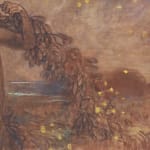Plinio NOMELLINI 1866 -1943
Further images
Exhibitions
Esposizione Internazionale dell’Industria e del Lavoro, Turin 1911
Literature
Gli arredi Spicciani. Tradizione lucchese e istanze internazionali nella produzione del mobile artistico toscano tra Ottocento e Novecento, by A. Belluomini, G. Borella, Florence 2006, p. 118-119
This panel by Plinio Nomellini (Leghorn 1866 – Florence 1943) entitled Lost in Meditation is back in the public eye 107 years after its first shown.
The new bourgeoisie was eager to acquire distinctive interior decor in the early 20th century and Carlo Spicciani, an artistic cabinet-maker from Lucca (Pescia 1879 – Lucca 1943) was one of their favourite craftsmen. His Art Déco design was enriched with painted panels, ceramics and glass inlay specially designed by leading artists, for instance with Galileo Chini's ceramic decoration.
The panel under discussion here was designed by Plinio Nomellini, along with others on marine subjects such as Seascape with Seagulls and Sails at Sunset and yet others conjuring up a romantic atmosphere such as Dawn and Night, for the Dining Room, an interior specially designed by Carlo Spicciani for the Esposizione Internazionale dell'Industria e del Lavoro in Turin in 1911. The panels only resurfaced in Florence in 1970 at a sale of the furnishings from Villa Giramonte handled by San Marco s.a.s., under the titles: Young Man with a Garland of Flowers in a Landscape and Bust of a Young Man in a Field of Poppies.
1911 marked the 50th anniversary of Italy's unification, an event celebrated with major international exhibitions and in keeping with the custom of the times numerous pavilions, both temporary and otherwise sporting the most original and varied architecture, were erected throughout the world. Rome witnessed major upheavals at Valle Giulia, at the Piazza d'Armi and in many other parts of the city, while in Turin the Parco del Valentino was chosen. In Florence, on the other hand, the anniversary was celebrated in Palazzo Vecchio with an Exhibition of Italian Portraits but without any specific decor being erected.
In 1911, in addition to showing his decorations for Spicciani in Turin at Valle Giulia, Plinio Nomellini also produced numerous panels on historical subjects and subjects related to Garibaldi for the Leghorn Pavilion at the Mostra Regionale ed Etnografica in Rome.
Nomellini and Spicciani continued to work together for several years. In 1913 Plinio Nomellini supplied Carlo Spicciani with two of his paintings, Working at the Docks and Returning Home from Work, for Villino Calderai in Rome, while Spicciano made the furniture and decoration for Nomellini's one-man show at the first Esposizione della Secessione Romana in 1913.
We have no letters from Nomellini recording any suggestions to the cabinet-maker for the subjects on the panels for the interior decor, but the artist's imagination certainly began to run riot when he was confronted with the pictures, as was his wont. The boy recall the features of his son Victor, who had already modelled for him as Young Bacchus, a picture now in the Galleria d'Arte Moderna in Palazzo Pitti in Florence, and in numerous other works.
Entry by Eleonora Barbara Nomellini
JOIN OUR MAILING LIST
Subscribe to our mailing list in order to receive news on new acquisitions, exhibitions, special previews and more!
* denotes required fields
We will process the personal data you have supplied to communicate with you in accordance with our Privacy Policy. You can unsubscribe or change your preferences at any time by clicking the link in our emails.

